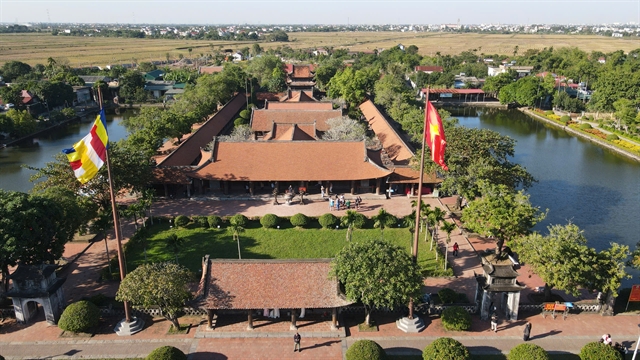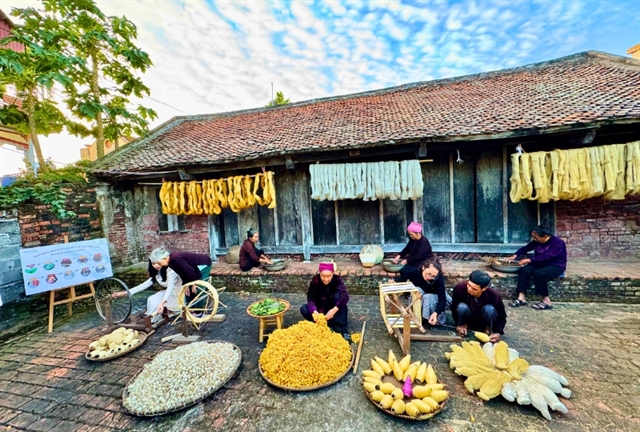 Life & Style
Life & Style

HƯNG YÊN — Many travel agencies and tourism associations discussed Hưng Yên’s tourism potential, and solutions to promote local tourism after the administrative merger at the Hưng Yên Tourism Promotion Conference 2025 held in the northern province of Hưng Yên on November 21.
The event, which gathered over 80 representatives from travel companies across the country, is part of a series of programmes jointly organised by the Vietnam National Authority of Tourism and the Hưng Yên Department of Culture, Sports and Tourism, following a field survey of various heritage sites, craft villages, and cultural spaces across the province.
The conference is also one of the key events of the Hưng Yên Culture, Sports and Tourism Week 2025, held from November 19 to 23.
 |
| Aerial view of Keo Pagoda in Hưng Yên Province. — VNS Photo Lê Phú |
Located in the heart of the Red River Delta, adjacent to Hà Nội, and within the Northern Key Economic Region, Hưng Yên has, after the merger, a total area of over 2,500 square kilometres with 104 communes and wards, and a population of more than 3.5 million people.
The province is home to over 3,500 heritage sites, including over 300 national monuments, six special national monuments, and 897 provincial-level monuments.
It also boasts 29 national intangible cultural heritages, 10 national treasures, 585 traditional festivals, and 58 types of folk performing arts such as chèo, ca trù, trống quân, hát văn, and water puppetry.
According to Phạm Văn Hiệu, deputy director of the Hưng Yên Department of Culture, Sports and Tourism, the province has all the conditions needed to develop comprehensive tourism.
Key destinations include the Phố Hiến Special National Relic Site, the Tombs and Temples of the Trần Kings, Keo Pagoda, Nôm Pagoda, and Dạ Trạch Temple. At the same time, spiritual tourism, ecological tourism, craft-village agricultural tourism, river tourism, and coastal tourism are creating many new opportunities.
In particular, Hưng Yên has a strong potential for coastal tourism with a 54-km coastline and pristine islets such as Cồn Vành, Cồn Đen, and Cồn Nhất.
The province also features wide tidal flats, long sandy beaches, and mangrove ecosystems in Thụy Hải, Thụy Xuân, and Thụy Trường, which are home to many rare bird species listed in the Red Book.
Community tourism and craft-village experiences also hold great potential, with numerous traditional craft villages such as Nam Cao linen weaving, Đồng Xâm silver engraving, and Lộng Thượng bronze casting.
However, many delegates openly acknowledged that Hưng Yên’s tourism has not developed in line with its potential.
Tourism infrastructure is lacking and deteriorating, there are few internationally-standard accommodations, and tourism products remain monotonous and repetitive. Storytelling, destination marketing, and visitor experience development are not yet coordinated. Signage systems, especially bilingual signs for international tourists, are still limited.
At Nam Cao linen weaving village in Vũ Tiến Commune, which is being positioned as a key craft-village tourism destination, travel companies recognise great potential but note that infrastructure has not kept pace.
The village roads are narrow and winding, there is a lack of directional signs, and even everyday issues, such as drying rice and grain along the paths, affect visitor safety.
Similarly, Keo Pagoda, a special national relic with unique architecture, has not received adequate investment in supporting facilities or in creating engaging storytelling experiences for visitors.
Dương Quốc Anh, representative of APA Travel, shared his impressions of the famtrip but also pointed out areas that need improvement: “Nam Cao craft village has great potential, but its image is not consistent and there is a lack of stories to tell. Young travellers like destinations with good reviews, but Hưng Yên is missing modern-style marketing. Keo Pagoda is beautiful, but it lacks connecting spaces to enhance the visitor experience.”
Meanwhile, Đòan Thị Tươi from Gali Travel noted that current destinations are mainly suitable for day tours due to a lack of accommodations, dining options, and supporting services. “To welcome hundreds of visitors, especially international groups, the current infrastructure is not sufficient,” she said.
From a regional connectivity perspective, Đặng Thị Thọ (Phoenix Voyages) suggested that Hưng Yên should develop inter-provincial tours connecting Hà Nội – Hưng Yên – Ninh Bình – Quảng Ninh – Hạ Long, forming a linked chain of heritage, cultural, and ecological products. She emphasised: “International travelers want journeys with diverse experiences. In the evenings, there should be night markets, entertainment services, and hotels that meet standards. Hưng Yên has potential but needs stronger and more coordinated efforts.”
 |
| Farmers at Nam Cao linen weaving village have preserved their craft for over 400 years. — VNS Photo Hồ Hạ |
Bùi Thị Thu Hiền, representative of the Hà Nội UNESCO Travel Club, noted that the province needs to redefine its tourism brand after the merger, invest in signage and destination recognition, and leverage its strength as the ‘cradle of Chèo art’, combining cultural value with the sea and mangrove forests to create a unique distinction.
Nguyễn Quý Phương, head of the International Relations and Tourism Promotion Department (Vietnam National Authority of Tourism), emphasised that Hưng Yên needs to “turn resources into real tourism products”.
According to him, achieving this requires coordination across infrastructure, services, workforce training, as well as internal and inter-provincial links.
Building a new tourism brand after the merger should also be a priority, tied to a long-term promotion strategy.
Hiệu stated that the province is implementing multiple solutions: improving destination infrastructure, upgrading accommodations, standardising tourism products, enhancing digital promotion, developing craft-village experience tours, linking key heritage sites, and establishing night markets and nighttime tourism services.
Hưng Yên aims to make tourism an important economic sector by 2030, contributing positively to local socio-economic growth.
This year, Hưng Yên aims for four million visitors and to generate VNĐ1.8 trillion (US$6.9 million) in tourism revenue. — VNS




